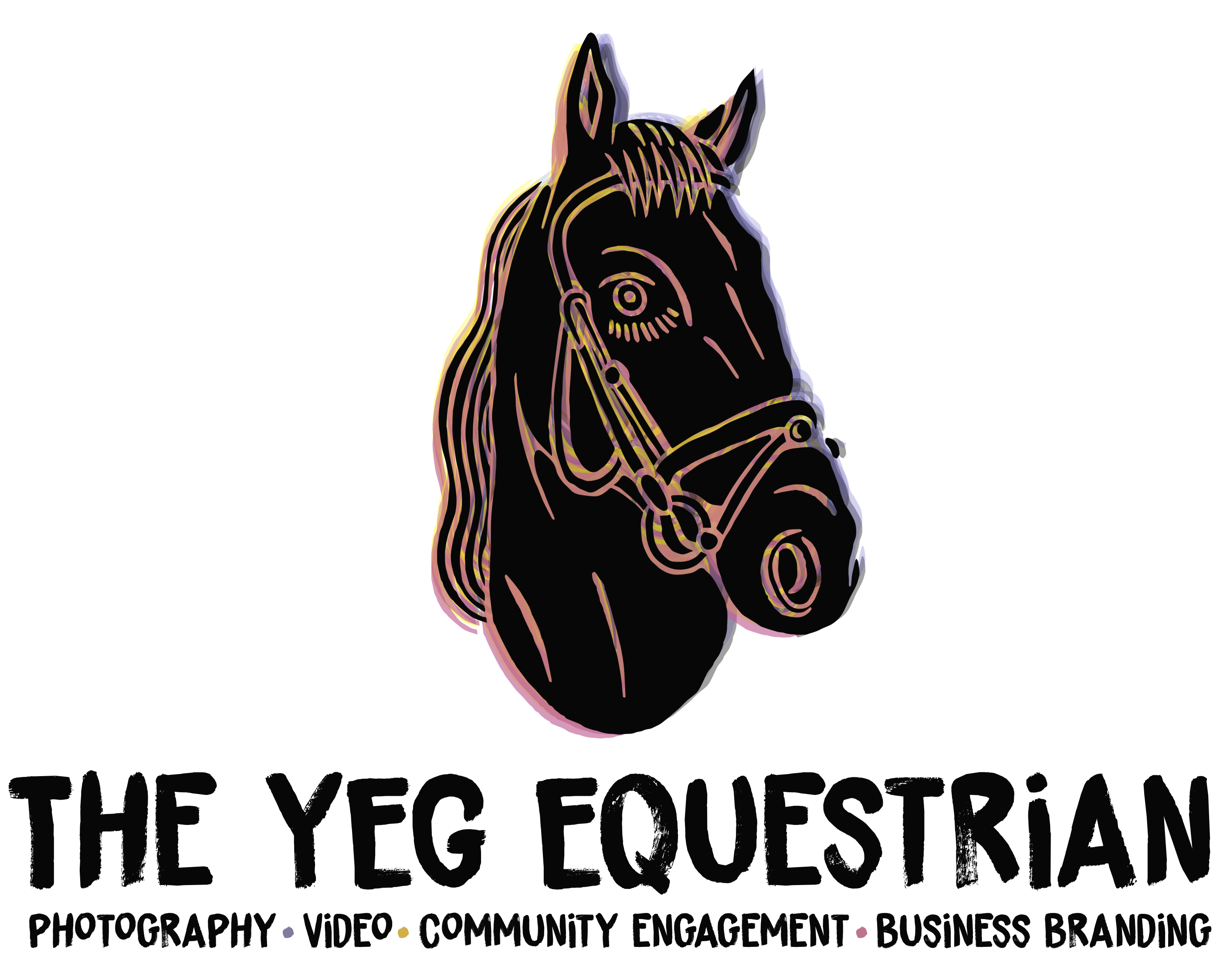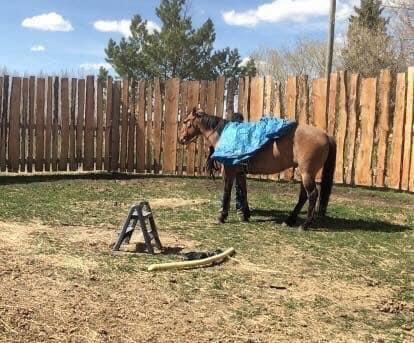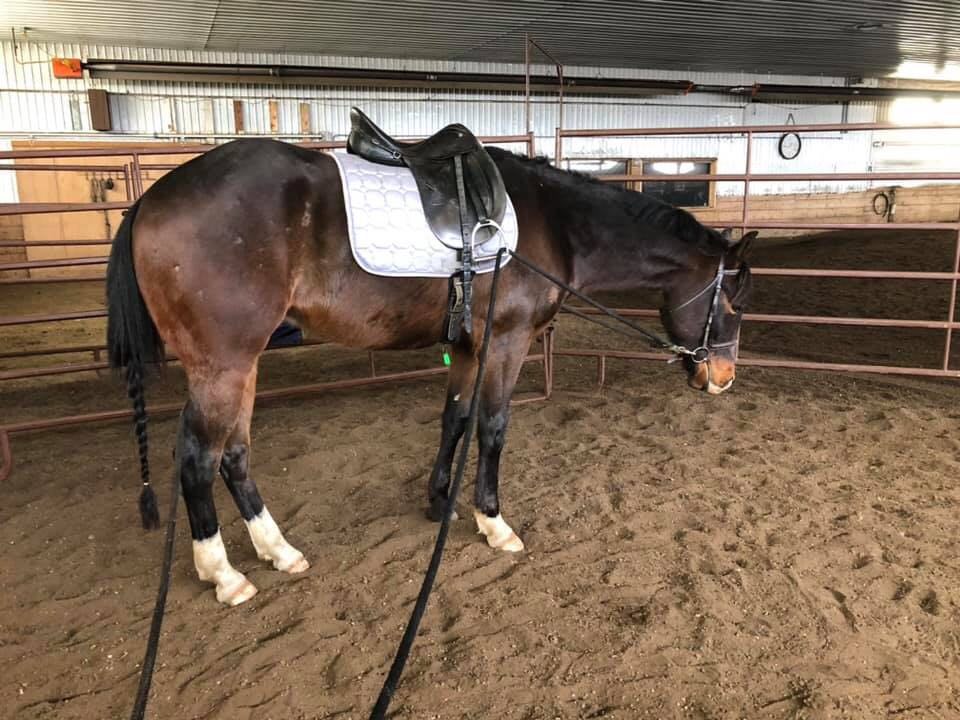Today I’m sharing some lovely insight from Sienna of Northern Hart Equestrian on colt starting! Even if you aren’t starting young horses this is an interesting read. A lot of these techniques can be applied to older/experienced horses as well! Thank you Sienna for taking the time to share your process with us!
Northern Hart Equestrian– Sienna Hart
Red Deer/Ambulatory, Colt starting English+Western, beginner hunter/jumper
https://www.facebook.com/northernhartequestrian/
(780) 915-1695
Colt start and horse training is not for the faint of heart, it’s hard work, lots of tears and constant questioning. But when you get it right and you see that horse go from an unhandled unhalter broke colt to someone’s lovely pleasure riding horse or future sport horse super star, you get all the job satisfaction one needs. The biggest thing about colt starting and horse training is to remember that it is not a cookie cutter business. It’s not something that A B C D works on every horse. What works for one horse will not necessarily work on another.
That’s why I highly recommend to future colt starters and horse trainers to take clinics from multiple people and even in multiple disciplines. The more you can learn about training horses, the more tools you have in your bag for the horses that come along in your career. At one time you might have a nice English riding horse but find your stuck on a problem. A method you learned from a cutting horse trainer may end up working brilliantly. I have had personal experience with cross training methods working out so well for a horse of a completely different discipline. A great trainer and colt starter I got to work under Jose Alejos said “We have enough people separating the horsemanship in cults already! So I like to think my job is to harmonize differences for the benefit of the horse, if we open up our awareness and stay humble, we can learn from everybody and from every horse. We never stop learning. That is why the world of the horses is fascinating”
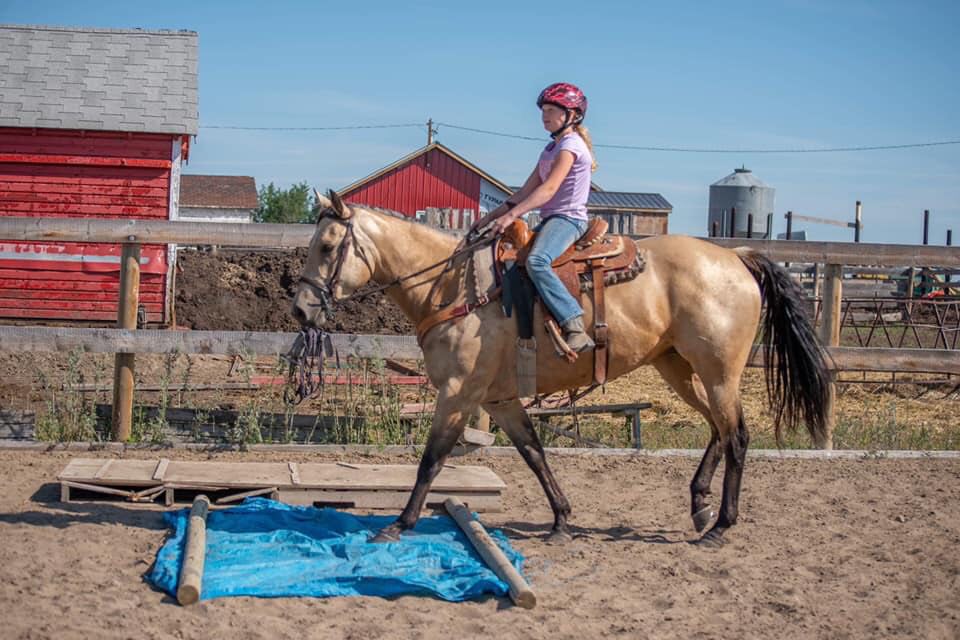
This is a general outline of how I like to start colts. Again this not what works for every horse this isn’t what I do for every horse. This is just my general program and some of the things I expect of my young horses and how to get some of the things I want out of them. The building blocks to have a lovely young horse. At the beginning its doesn’t matter to me if your horse is a western or English horse. To me the principals are all the same. The things you need from your young horse are all the same. I’m starting from having a young colt who is already halter broke, accepting of my touch and being brushed. We are getting ready to put the tack on and move up from there.
• The first thing I do with my young horse is get them in the round pen and put a bridle on them. Some horses take a long time to accept the feel of a bit in their mouth. Doing this off the hop gives them a very long time to accept that feel. Most of my young horses I start in a simple double jointed loose ring snaffle. I find it is soft on the bars of the mouth with no nut cracker effect on the tongue. Its got a lot of play and movement and lots of young horses are more accepting of that (I do see where some horses maybe better in a happy mouth straight bar if this is too much play) again not cookie cutter situation.
• Next I like my horses to get a good “sacking out”. This is not a beating, or to scare the horse as some people think. This is about teaching my horse to problem solve. Some people may also refer to this as pressure/release. If my horse learns to problem solve now at stage one, later on when he gets unsure (for example when I get on him) he’s already learned how to handle the situation. He’s already learned that he should look to me for the answer. That he should not run away, ball up or go into himself. Sacking out is a real process of teaching your horse how to handle new situations or problems. Where he looks to you to tell him it’s ok. For example the first time he goes to a horse show, or has to cross a creek.
• A few other things I like to do with my horses is work them with a tarp, a pool noodle, yoga ball, ropes and a flagging stick. I teach my horses to accept me taking the tarp and touching them with it. I approach them at the shoulder. It’s the space they find the least offensive. From the head or that tail horses take things at a more predator vs prey aspect. I run the tarp all over their bodies, on both sides. Once they have accepted that I like to put the tarp over their backs. I start out with it folded up. Asking the horses to take one or two steps. Talking calmly to them and reassuring them. If they go to move I just use the halter to keep their head turned and tell them whoa. There’s no point fighting them. They need to learn the skills, not to be forced. We are trying to create a confident horse. Once they stop I may even pull the tarp off for a minute. Then return it. They learn when they move the tarp doesn’t leave. When they stand quiet it goes away. Then slowly I open it all the way up so it hangs from ears to tail even at times letting it drag behind their bums and on the ground. Again getting them to take a few steps at a time and then stopping them. After this is want to see them relax by either dropping their head, licking their lips or blowing there nose. They should be able to walk all over the round pen and change directions without being upset.
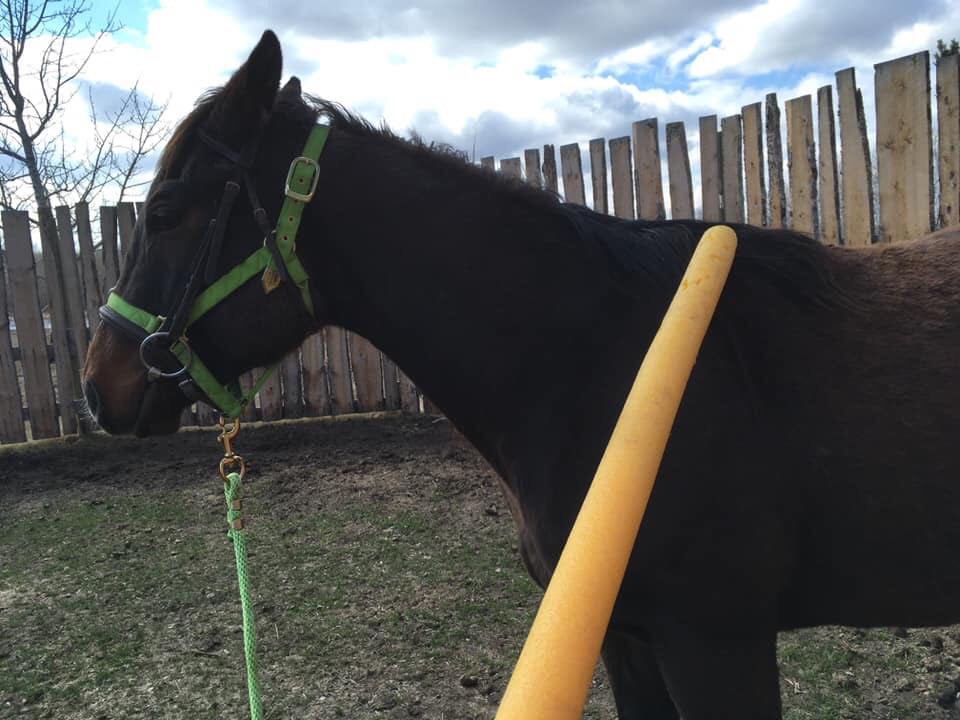
• Next I work on making them walk over the tarp. There is two ways to go about this. First if the horse is really nervous, i’ll hold on to it and walk with it. The tarp should be on the same side as they are. Once in a while let it fall so they have to step over it. Others you can simply open it up and walk over it first yourself. Allowing them to sniff at it and look. They see me walking over it and see its ok. Be careful you are not out front so if they get nervous you don’t get stepped on. Once my horse confidently follows me over the tarps I want them to lunge over the tarp on their own, or just stand with all four feet on it.
• Next they learn to push the yoga ball around. It teaches them confidence about their feet, it teaches them about their legs. It teaches them if things touch their legs they don’t have to freak out. Depending on the horse I will walk them up to the ball and ask them to step forward and push it. Others I may bring the ball to them and set the ball. Again you need to gauge what your horse can handle. You want to make them touch the ball on their front legs and their back legs. They should then be confident that they can walk forward and push the ball. You can then place the ball and put it up on their backs. Roll it around so they get used to something being up above them. Putting the ball on their backs and letting it role to the off side is also great. A lot of horses don’t like but it teaches them about contact on the off side when your on the other. As it rolls and bounces watch they don’t jump into you. You want them to learn to stand and accept it. Some horses end up truly loving the ball and will actually find their relaxation in pushing it around. I had a horse Zedigo who was very nervous and tense. I taught him from the ground to enjoy pushing the ball. Once I got on his back you would feel him tense up. I would walk him up to the ball and he would completely forget about being scared. He would chase the ball over the whole arena. Even trotting and cantering to get it. Videos are located on my Northern Hart Equestrian page. After 5 minutes of play with the ball he was relaxed and ready to work on whatever was asked of him. The pool noodle and flag are the same aspect as the ball. Its about touching them with different things. Them accepting everything right from the head to a back leg and standing still. This all very general but use the same steps. Some horses are more accepting of different things so this just shows them a variety of things and get them more “broke” and willing.
• Next we are going to play with the rope. The rope is important as this is for teaching our horses about cinching and ground driving. I want my horse to be ok with this all over their bodies, legs and butt. We will start with the cinching. Too many people say “my horse is cinchy/girthy” or he gets upset while I tack him. This breaks down to either a- ulcers or b- not correctly cinching your horse. What I like to do with my colts is put the rope over their backs and then bring it back around under their belly. So now I have two ends of rope around the same side/position that I would do up a girth or cinch. I slowly increase some pressure and then release. Each time taking a little more pressure. Again gauge where your horse needs to start. Horses are claustrophobic. So some can handle some pressure right off the bat where others just having the rope all the way around is too much. Work with them as they need. If you have a western horse also work on moving that rope back, to about the position of the back cinch. Again first start very light and work your way to a decent pressure. Even with your good broke horses, don’t just do up your girth and yank it up to where it supposed to be. Be polite start with a light pressure and give them a minute or two, then up a few more. Walk your horse to the ring, recheck and maybe tighten again. A lot of horses become “bloaters” from having someone go from 0 to 60 in 10 seconds. I had one horse who actually would lay down when you would girth him! So take your time, and be polite. You wouldn’t like someone reefing on your belt and sucking you in. Also rule of thumb is to be able to still get a finger in the girth.
Now you want your horse to get use to pressure on the bit and accepting the rope around the butt. Now here again there is a big split. Some horses can go right into this and some need more reassurance. These ones just standing next to them and bend their heads around accepting that pull on the bit. Some horses need one side rein tied from the bit to the girth and just get use to the feel of their head bending around and being able to move into that bend. If you have questions on that feel free to message me on facebook. We are going to take this as a horse who is very accepting of bend and taking the bit. If I’m going to be standing on the left side of my horse, I attach the rope to the right bit ring. Then bring the rope up their neck. I then stand on the left side. I feed the rope over their back and let the rope drop over their bum. They may get confused at first as they are being asked to turn away from you. Just be patient and wait. They will figure it out. With a medium pressure start to pull on the rope. The horses head will turn to the right and slowly swing around and then they will turn and come back to face you. Do this a few times and then switch sides. They get confused the first time to the other side, but again just wait them out.
• Now we are ready for ground driving, but this can also come at different stages. Some people ground driving with a surcingle before introducing tack and some do it with tack. I prefer to tack and then ground drive. Step one is to introduce the saddle pad. Do this the same as you did the tarp. Touching them with it and running it over their body. Start lightly and then just flop it on to them. Do this from both sides. Golden rule is whatever you do to one side you should do to the other.
Next I take the saddle and place it on them. Some people will rush to get the cinch done up as they are worried about bucking. However we have done all this prep work and I will say 99.9 percent of my colts are never upset about the saddle at this point. For me I like to just put it on them and like before just have them take a few step with it, without a girth on. Horses are creatures of repetition. They like to know the black and white of what’s going to happen. So if we approach each new problem the same way they are more likely to understand and be accepting. Once my horse has taken a lap around with the saddle, then I’ll do my saddle up. Again starting gently, walking a few steps and then tightening it a little more.
Now that my horse is fully tacked up I make sure my stirrups are tightened to my girth. This way they can’t flop around. I run my ropes from the bit through the stirrups and then back to myself. Ill ground drive them going both directions. Once they are relaxed I’ll ask them to do some walk and trot transitions. As I ask for the transitions I tell them what I want ie “walk” “trot” “whoa”. I don’t really worry about the lope for most horses. But again gauge each horse you are working and how much can they handle. It is also important to practice some halts. My horse then has understanding of steering, voice commands and knowing what I want before I even get on them. The whole time I’m a believer about my voice commands. This way when I get on they already know the words.
• Next it’s time to work on mounting. I will bend their head toward me. That way they are paying attention and can’t run away from me or with me. If they get nervous their body will swing away from me. I’ll start by grabbing the stirrups and pulling on them, banging them around a bit. I’ll reassure my horse by saying whoa and asking them to stand while I do this. Next I will jump up and down next to them. Start with small jumps and slowly start bounding higher while pulling on the saddle. This teaches them they should not move while I’m moving around them, or while I’m trying to get on them. Once the horse is good with that, I’ll put my foot in the stirrup and lay across them and pat them. Sometimes some horses let you up for a bit, some you may be up and down a few times before you feel them settle. What you are looking for is for them to stand still while you get up and lay across. I want to pet their off side and be able to pet up their neck and down around their bum. Do this to both sides. If you are ever in an emergency situation you may need to get on or off your horse from the off side, so this is important. We don’t want that to be a big deal. Once my horse accepting of that I will swing a leg over.
Depending on the horse, some need to have you turn their head the way you did in our initial rope work and that will get them to swing their hips to the side and start moving those feet. Stop and start while doing that. As they feel confident you can slowly release their head as they circle and they will start to step out on to a bigger circle and then into a straight line. Using my voice to also tell them to walk on. I also have many colts who are already very good with the command and me telling them to walk on is enough for them to step out and be ok. At this stage in the game I just want my horse to step out relaxed. No real pressure on the reins, feeling their backs swing. Most horses with all the work you have done do this very confidently right of the bat. Again listen and watch your horse. Know how far you can push. Maybe you take two steps and then hop off and reward them. Then get back on and ask for four or five steps. Any time you see your horse try you are going in the right direction. It won’t always be leaps and bounds. Forward is still forward. These steps make for a solid foundation for your future horse. They are the building blocks that so often get missed. I would never get on a horse who won’t stand for mounting, I won’t walk on until my horse is relaxed while I sit on them. I find too many people rush their horses through this part of training. These horses then tend to have mounting issues, or end up being horses that bolt or are unsure. It saves your horse in the end to take the extra time. You won’t find holes later.
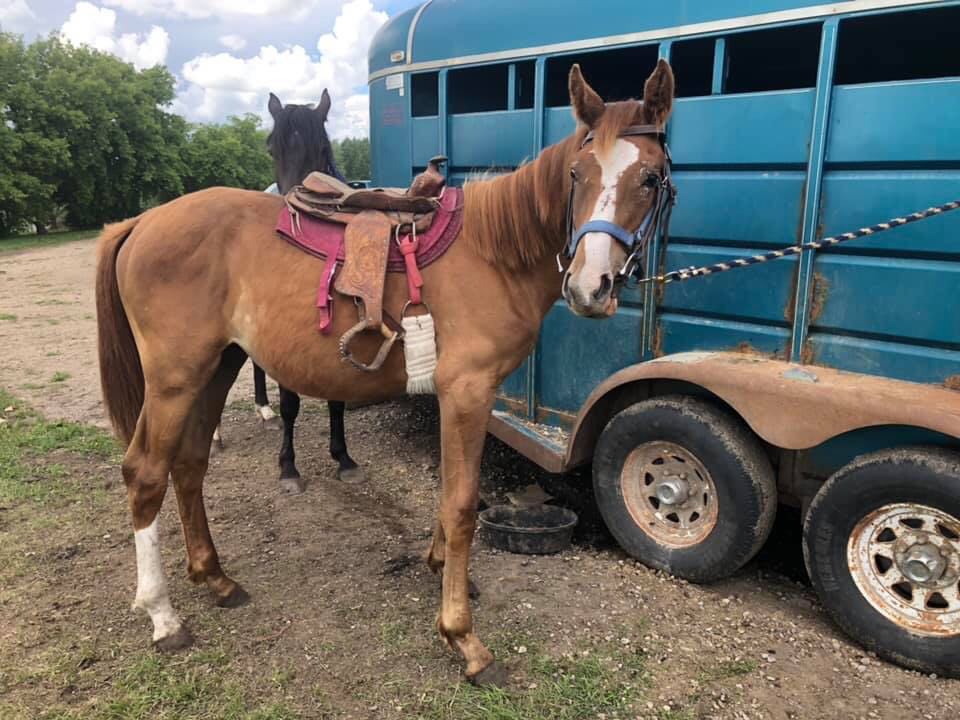
• A big thing to take in to consideration is to judge how much your horse can handle in a day. To me this is far too much for one day. Most young horses don’t have a long attention span. Some can handle 20 minutes, some can handle an hour, some are having a bad day and you may take 2 hours to explain one aspect of one thing to them. You need to read your horses. I have even had horses where you get a good session out of them and they have picked up a lot and they actually do better with one day off between each session. Some of these may just be mentally immature horses who need time to process and be young in-between.
After this I have my horse walking both directions, trot both directions and stop. I don’t really worry about the lope in my round pen as its not huge. I find some young horses just aren’t ready for it either. They are just mentally or physically not there yet. I find this more so in the young Warmbloods. Some of these breed or just the individual horse is not ready until there 3 years old. I’m not afraid to put thirty or sixty days on a horse and then kick them out for a year to grow physically and mentally. We have to remember that this is a game we play for the long run, creating longevity in our horses. Not breaking them down mentally or physically when they are just young.
• Once my horse has this down, I will move them into my big arena. Just as I said before I will make it just like a new lesson. They know how we work the building blocks. So I will quickly browse over everything. Starting with ground driving, then lay over them and then all the way mounted. Finally walking and trotting off. They already know all these things. It will set their minds and ease them as they have an idea of what is coming. They are more accepting. When you’re riding your young horse the biggest thing is rhythm. Horses find relation through rhythm. Don’t be getting on your horses and let them pick up a crazy fast trot and then super slow trot. Get your horses in a 1..2..1..2.. rhythm like a metronome. Once your trotting them around large, put them on the circle. Also get them to practice stopping and hanging out. Get them going across the arena. All these things sound simple but when a colt is green they need this direction. They don’t understand. Especially coming off the rail in a big arena, some colts find that scary. If your horse becomes nervous don’t be afraid to take it back down to a walk. Ask them to walk across the ring first.
• When my horse is really comfortable I will ask for the lope. Depending on your horse I will ask them differently. On my nervous horses I will ask them on a circle and then out on the rail. Around that ¾ mark I’ll ask them to pick up the canter. If they want to take a big trot step into it that’s fine. I will tell them to canter as well with my voice. Other horses who are a little more laid back I will ask on a long wall corner. It just gives them that longer space to look at. It’s easier for them, less thinking about turning and more just going forward. Now some horses take those first few lope steps and start to feel tense. Even if my horse gives me one or two strides and then I bring them back I pet them. They are trying, they are thinking. I’d rather ask them and bring them back before they get tense and start having a problem. Each time I will start to ask them to go a little further.
Some may get a little excited and want to pick up more of a faster pace. So I will have a little contact with the outside rein, giving them a little check on it. Just ask them to keep that pace away from a run or a gallop. Never letting their feet get faster than their brains.

So that’s the basics of getting my horses started. After this it’s pretty open. For me I like to get my horses more exposed to new things. Taking them out on the trail, or hauling them to other arenas. Especially if they are young I’d rather them see a lot then to necessarily do a lot of pressure work. I wouldn’t always push them to get on the frame or give me a sliding stop. Again this is all dependent of how old your horse is or what breed your horse is and how mentally mature your horses is. That’s a huge factor. Some horses can do walk and trot in 30 days. Some can be out on the trail on their own in 30 days. Some horses don’t know where there legs are and you might be risking an accident or they are still too nervous. You may just need to kick them out for a few months or a year and then they come back a totally different horse. They haven’t lost or have lost very little of what you taught them and they are ready for the next step. You can add the buttons later when their body and brain is ready. But a solid foundation is number one.
Again this isn’t for everyone and not every horse. Have fun, stay safe and make some nice relaxed horses who have bright futures. Don’t be afraid to contact me if you have further questions or would like your horse trained!
Thanks so much Sienna for that detailed look at all the work that goes into starting those young minds and bodies! If you enjoyed our write up please share. Or if you have an idea for a feature, get in touch at hello@theyegequestrian.com!
